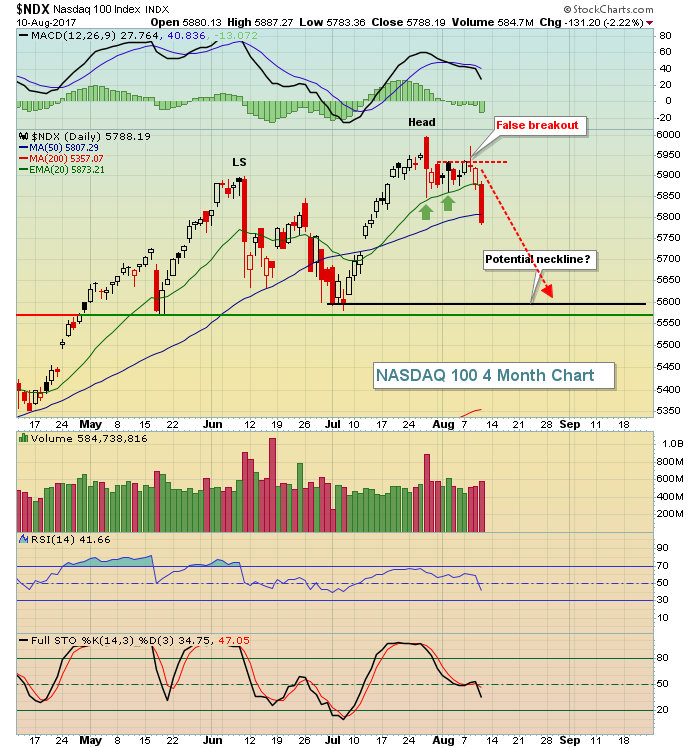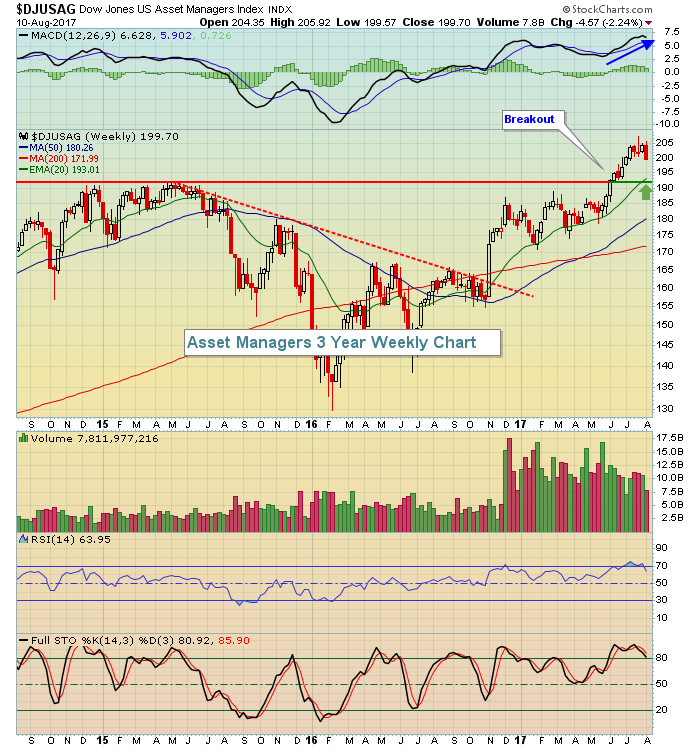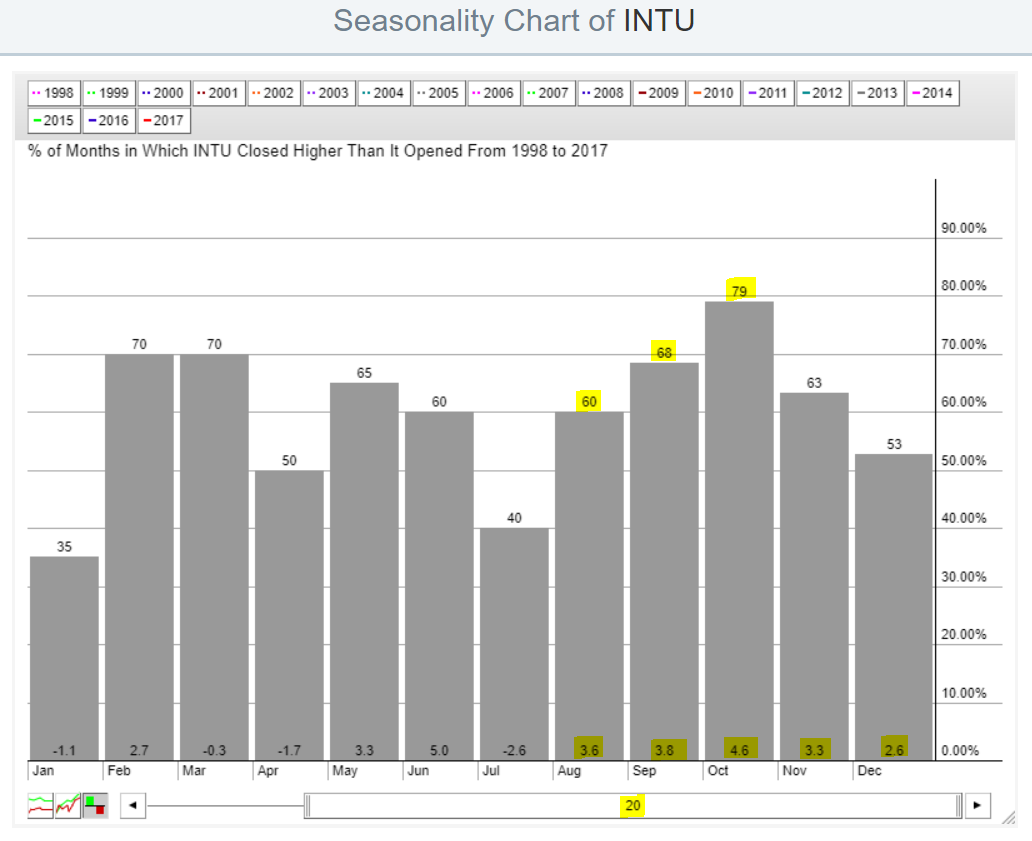Market Recap for Thursday, August 10, 2017
Technology (XLK, -1.97%) and financials (XLF, -1.78) led a steep selloff in equities on Thursday. It wasn't the worst day of the year for the NASDAQ, but it was pretty close. That aggressive index lost both its 20 day EMA and 50 day SMA yesterday and futures are lower again this morning. Prepare for more weakness. We'll get a temporary bounce soon, but it's not likely to last as another significant leg lower will probably follow.
So where do we go from here, now that key moving averages have been lost? Two days ago, I posted a NASDAQ 100 ($NDX) chart that highlighted my expectations in the near-term (next 4-6 weeks). Here is it:
 I didn't like that false breakout and that, combined with ugly weekly divergences, suggested that the risk of a significant pullback was growing. The Volatility Index ($VIX) rose 44% yesterday, to close above 16 for the first time in 2017. When the VIX is rising, all bets are off as to how low we might go in the very near-term. The stock market has a history of going down much faster than it goes up. When fear escalates, bears feast. This is no time to be a hero.
I didn't like that false breakout and that, combined with ugly weekly divergences, suggested that the risk of a significant pullback was growing. The Volatility Index ($VIX) rose 44% yesterday, to close above 16 for the first time in 2017. When the VIX is rising, all bets are off as to how low we might go in the very near-term. The stock market has a history of going down much faster than it goes up. When fear escalates, bears feast. This is no time to be a hero.
History tells me that long-term tops don't form with VIX readings at historical lows. Tops require a process as the market shifts from complacency to fear. It's WAAAAY too early to determine if this top was the last one before a bear market sets in. But I don't believe that at all. In fact, I think selling in August and September will set up an awesome rally into year end. The key during that rally will be......which sector(s) lead? If we're led by defensive stocks and the VIX remains elevated, that'll likely suggest a bear market is right around the corner. If, on the other hand, money rotates back into aggressive areas of the market and we forge new all-time highs, then I'd bet the current bull market rages on.
Time will tell and there's no substitute for time.
Pre-Market Action
Inflationary pressures are under control as the July CPI was just released and both the total number and core came in below expectations, +0.1% vs. +0.2% consensus estimates. That may calm fears of further rate hikes by the Fed - at least temporarily - and this morning's bond market reaction suggests the same with the 10 year treasury yield ($TNX) down another tick to 2.20%. The TNX has been in steady decline for the past several weeks and that has been hurting banks ($DJUSBK) and life insurance companies ($DJUSIL) while helping utilities (XLU) and REITs ($DJR), although the latter has fallen in August.
Global markets struggled overnight in Asia and continue to do so this morning in Europe. The German DAX ($DAX) has just crossed below the 12000 level for the first time since late April. Gold ($GOLD) is creeping closer and closer to its key long-term downtrend line resistance near 1300. At last check, it was 1292 this morning.
Dow Jones futures look to start off the morning flat, having improved from earlier lows.
Current Outlook
The ratio of transports vs. utilities ($TRAN:$UTIL) hit a 2017 low yesterday and that's not a good sign. I wrote yesterday about the technical issues facing transports, mostly negative divergences, so this relative breakdown is confirming weakness in this area of the market and the fact that market participants are not buying into the "strengthening economy" rhetoric of the Fed:
 It's been a rough month for transports and I don't see it getting any better anytime soon. As I said in prior blog articles, stay cautious for now.
It's been a rough month for transports and I don't see it getting any better anytime soon. As I said in prior blog articles, stay cautious for now.
Sector/Industry Watch
The Dow Jones U.S. Asset Managers Index ($DJUSAG) was hit hard on Thursday and the group is part of the financial sector. While the 2.40% drop yesterday was severe, this is actually one of the best looking industry groups within the financial sector and further weakness could set up a nice opportunity here. When momentum is accelerating (rising MACD), pullbacks to test rising 20 period EMAs are normally solid areas of entry. Check out the DJUSAG weekly chart:
 In the short-term, I'd expect more weakness here. Two of the last three weekly candles are bearish, including the current bearish engulfing candle. Expect a 20 week EMA test - so perhaps another 3% or so downside. That rising 20 week EMA is also close to key price support established from the June breakout. Therefore, there are a couple of significant technical reasons for buyers to jump in around the 192-193 level.
In the short-term, I'd expect more weakness here. Two of the last three weekly candles are bearish, including the current bearish engulfing candle. Expect a 20 week EMA test - so perhaps another 3% or so downside. That rising 20 week EMA is also close to key price support established from the June breakout. Therefore, there are a couple of significant technical reasons for buyers to jump in around the 192-193 level.
Historical Tendencies
Intuit (INTU) might be a stock to consider as it's holding up fairly well technically, while also having just entered its best performance time of the year. August through December has historically been a very strong period for INTU as you can see below:
 Average monthly gains range from 2.6% (December) to 4.6% (October) in each of the five months during this period.
Average monthly gains range from 2.6% (December) to 4.6% (October) in each of the five months during this period.
Key Earnings Reports
(actual vs. estimate):
JCP: (.09) vs (.06)
MGA: 1.48 vs 1.47
TU: .51 vs .56
Key Economic Reports
July CPI released at 8:30am EST: +0.1% (actual) vs. +0.2% (estimate)
July Core CPI released at 8:30am EST: +0.1% (actual) vs. +0.2% (estimate)
Happy trading!
Tom
